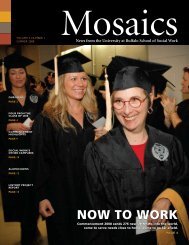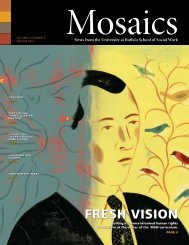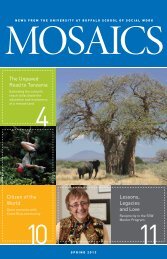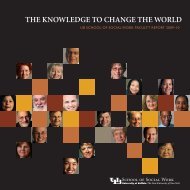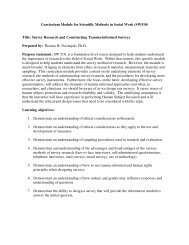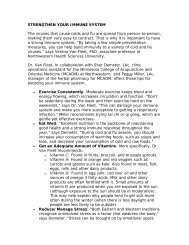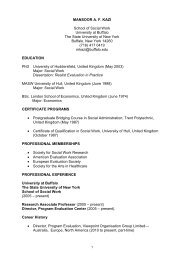On tO atlanta - UB School of Social Work - University at Buffalo
On tO atlanta - UB School of Social Work - University at Buffalo
On tO atlanta - UB School of Social Work - University at Buffalo
Create successful ePaper yourself
Turn your PDF publications into a flip-book with our unique Google optimized e-Paper software.
Mosaics<br />
Volume 4, Number 1<br />
summer 2009<br />
Mosaics<br />
News from the <strong>University</strong> <strong>at</strong> <strong>Buffalo</strong> <strong>School</strong> <strong>of</strong> <strong>Social</strong> <strong>Work</strong><br />
Our news<br />
page 2<br />
THREE FACES IN<br />
THE ’09 BOOK<br />
page 6<br />
LESSONS FROM<br />
PAKISTAN<br />
page 11<br />
PEOPLE PEOPLE<br />
page 12<br />
Classnotes<br />
page 13<br />
DEVELOPMENT:<br />
HONOR THE STUDENT<br />
page 15<br />
<strong>On</strong> to <strong><strong>at</strong>lanta</strong><br />
Wh<strong>at</strong> started as an internship led Robin Hartinger-Saunders through two <strong>UB</strong><br />
social work degrees to a faculty appointment <strong>at</strong> Georgia St<strong>at</strong>e <strong>University</strong>.<br />
page 4<br />
mosaics : Summer 2009 1
Mosaics<br />
Mosaics, the newsletter <strong>of</strong> the <strong>UB</strong> <strong>School</strong><br />
<strong>of</strong> <strong>Social</strong> <strong>Work</strong>, is produced three<br />
times a year by the Office <strong>of</strong> <strong>University</strong><br />
Communic<strong>at</strong>ions, Division <strong>of</strong> External<br />
Affairs. July 2009.<br />
09-SOC-001.<br />
www.socialwork.buffalo.edu<br />
The <strong>University</strong> <strong>at</strong> <strong>Buffalo</strong> is a premier<br />
research-intensive public university, the<br />
largest and most comprehensive campus<br />
in the St<strong>at</strong>e <strong>University</strong> <strong>of</strong> New York.<br />
<strong>UB</strong>’s more than 28,000 students pursue<br />
their academic interests through more<br />
than 375 undergradu<strong>at</strong>e, gradu<strong>at</strong>e and<br />
pr<strong>of</strong>essional degree programs. Founded<br />
in 1846, the <strong>University</strong> <strong>at</strong> <strong>Buffalo</strong> is a<br />
member <strong>of</strong> the Associ<strong>at</strong>ion <strong>of</strong> American<br />
Universities.<br />
editorial team<br />
Jessica Perkins<br />
Gradu<strong>at</strong>e Assistant<br />
<strong>School</strong> <strong>of</strong> <strong>Social</strong> <strong>Work</strong><br />
Barbara Rittner<br />
Associ<strong>at</strong>e Dean for External Affairs<br />
<strong>School</strong> <strong>of</strong> <strong>Social</strong> <strong>Work</strong><br />
Jud Mead<br />
Newsletters Coordin<strong>at</strong>or<br />
Office <strong>of</strong> <strong>University</strong> Communic<strong>at</strong>ions<br />
Lauren Maynard<br />
Newsletters Editor<br />
Office <strong>of</strong> <strong>University</strong> Communic<strong>at</strong>ions<br />
Design<br />
Nick Peterson<br />
Office <strong>of</strong> <strong>University</strong> Communic<strong>at</strong>ions<br />
Cover Photo: KC Kr<strong>at</strong>t<br />
Our News<br />
SSW and Community<br />
Connections<br />
<strong>School</strong> <strong>of</strong> <strong>Social</strong> <strong>Work</strong> faculty delivered<br />
invited talks and made present<strong>at</strong>ions <strong>at</strong><br />
conferences across the country this spring.<br />
Here are highlights.<br />
• Diane Elze delivered a <strong>Social</strong> <strong>Work</strong><br />
Month talk titled “<strong>Social</strong> <strong>Work</strong> as Poetry:<br />
Passion, Purpose, Possibilities and Power” <strong>at</strong><br />
the Veterans Affairs Medical Center in <strong>Buffalo</strong><br />
to honor the role <strong>of</strong> VA social workers<br />
in the care <strong>of</strong> veterans and their families.<br />
Elze (third from right) with VA social workers<br />
• Mansoor Kazi spoke <strong>at</strong> Women and<br />
Children’s Hospital <strong>of</strong> <strong>Buffalo</strong> on the evalu<strong>at</strong>ion<br />
<strong>of</strong> arts in health care.<br />
• Barbara Rittner spoke on marketing<br />
and branding <strong>at</strong> the Associ<strong>at</strong>ion <strong>of</strong> Baccalaure<strong>at</strong>e<br />
<strong>Social</strong> <strong>Work</strong> Program Directors<br />
conference in Phoenix, Ariz.<br />
Celebr<strong>at</strong>ing Field Educ<strong>at</strong>ors<br />
• Deborah Waldrop and Sharon Herlehy<br />
(MSW ’90), assistant director <strong>of</strong> field educ<strong>at</strong>ion,<br />
gave a present<strong>at</strong>ion on standardized<br />
p<strong>at</strong>ients for the Associ<strong>at</strong>ion for Gerontology<br />
in Higher Educ<strong>at</strong>ion in San Antonio, Texas.<br />
• Kelly P<strong>at</strong>terson presented a paper on<br />
fair housing barriers <strong>at</strong> American Society<br />
for Public Administr<strong>at</strong>ion in Miami, Fla.<br />
• Adjoa Robinson presented for the<br />
Building on Family Strengths conference in<br />
Portland, Ore.<br />
• Filomena Critelli (MSW ’77) presented<br />
<strong>at</strong> the fifth Intern<strong>at</strong>ional Congress<br />
<strong>of</strong> Qualit<strong>at</strong>ive Inquiry <strong>at</strong> the <strong>University</strong> <strong>of</strong><br />
Illinois <strong>at</strong> Urbana-Champaign.<br />
• Doctoral student Brian Pagkos (MSW<br />
’03), Mansoor Kazi and Heidi Milch (MSW<br />
’98), CEO <strong>of</strong> Community Connections <strong>of</strong><br />
New York, presented findings from a study<br />
on wraparound services <strong>at</strong> the <strong>University</strong> <strong>of</strong><br />
South Florida Research and Training Center<br />
for Children’s Mental Health.<br />
• Laina Bay-Cheng and doctoral<br />
student Nicole Fava (MSW ’08) made a<br />
present<strong>at</strong>ion on adolescent girls’ sexual assessment<br />
and management <strong>at</strong> the American<br />
Psychological Associ<strong>at</strong>ion Convention in<br />
Toronto, <strong>On</strong>tario.<br />
The gardens <strong>at</strong> the <strong>Buffalo</strong> and Erie County Historical Society were in full bloom for this<br />
year’s Field Educ<strong>at</strong>ors Award ceremony on April 30. The event honored 27 nominees from<br />
a variety <strong>of</strong> field settings reflecting such dispar<strong>at</strong>e areas <strong>of</strong> practice as the United Way, legal<br />
agencies, schools, family and children services agencies, <strong>UB</strong>’s CARES program (a dental and<br />
social work schools collabor<strong>at</strong>ion), as well as mental health and hospital settings. These committed<br />
educ<strong>at</strong>ors make a difference every day by providing quality learning opportunities to<br />
MSW students and serving as social work pr<strong>of</strong>essional role models. This year’s Outstanding<br />
Achievement in Field Educ<strong>at</strong>ion Award was presented to Kristen Luppino (MSW ’05), from<br />
the Erie County Coalition Against Family Violence.<br />
2 mosaics : Summer 2009
Intern<strong>at</strong>ional Developments<br />
In l<strong>at</strong>e May, Jay Misra, director <strong>of</strong> Intern<strong>at</strong>ional<br />
Affairs/Alumni Affairs <strong>at</strong> Amrita<br />
<strong>University</strong> in Tamil Nadu, India, visited a<br />
number <strong>of</strong> departments <strong>at</strong> <strong>UB</strong> and made a<br />
present<strong>at</strong>ion to social work students, faculty<br />
and staff. Misra is on the<br />
faculty <strong>at</strong> Amrita <strong>School</strong> <strong>of</strong><br />
Business. This visit was a prelude<br />
to the planned August<br />
visit to Amrita <strong>University</strong> by<br />
Diane Elze, director <strong>of</strong> the<br />
MSW program; Laura Lewis,<br />
director <strong>of</strong> field educ<strong>at</strong>ion;<br />
and Dean Nancy Smyth, to<br />
Misra<br />
explore a possible partnership<br />
with the <strong>School</strong> <strong>of</strong> <strong>Social</strong> <strong>Work</strong>. Misra<br />
described grassroots community activism<br />
in their social work department th<strong>at</strong> ranges<br />
from building affordable housing to running<br />
orphanages to developing NGOs.<br />
In addition to the planned trip to<br />
India, faculty from the <strong>School</strong> <strong>of</strong> <strong>Social</strong><br />
<strong>Work</strong> will particip<strong>at</strong>e in a trip to explore<br />
the development <strong>of</strong> a school for girls in<br />
Tanzania. The trip was organized by Mara<br />
B. Huber, special assistant to <strong>UB</strong> president<br />
John B. Simpson and director <strong>of</strong> <strong>UB</strong>’s Center<br />
for Educ<strong>at</strong>ional Collabor<strong>at</strong>ion (CEC), who<br />
learned <strong>of</strong> the urgent need for such a school<br />
during a serendipitous encounter with<br />
Tanzanian nuns. Joining Huber in Tanzania<br />
will be K<strong>at</strong>ie Biggie, also from the CEC;<br />
K<strong>at</strong>hleen Kost, <strong>School</strong> <strong>of</strong> <strong>Social</strong> <strong>Work</strong>; Mary<br />
Gresham, dean <strong>of</strong> the Gradu<strong>at</strong>e <strong>School</strong> <strong>of</strong><br />
Educ<strong>at</strong>ion; Brian Carter, dean <strong>of</strong> the <strong>School</strong><br />
<strong>of</strong> Architecture and Planning; Annette<br />
Lecuyer, <strong>School</strong> <strong>of</strong> Architecture and Planning;<br />
Kevin Crosby from Full Circle Studios;<br />
and Brenda McDuffie, president and CEO <strong>of</strong><br />
the <strong>Buffalo</strong> Urban League.<br />
C<strong>at</strong>herine Dulmus and doctoral student<br />
Amy Manning (MSW ’03) presented a poster<br />
<strong>at</strong> the 2009 Campbell Collabor<strong>at</strong>ion Colloquium,<br />
Oslo, Norway. Dulmus also presented<br />
a poster with Bruce Nesbit (MSW ’74), CEO<br />
<strong>of</strong> Spectrum House, and doctoral students<br />
Manning and Nicole Tomasello (MSW ’02),<br />
<strong>at</strong> the World Psychi<strong>at</strong>ric Associ<strong>at</strong>ion Intern<strong>at</strong>ional<br />
Congress, Florence, Italy.<br />
U-Presence on YouTube<br />
The <strong>School</strong> <strong>of</strong> <strong>Social</strong> <strong>Work</strong> has opened its<br />
own You Tube channel <strong>at</strong> www.youtube.com/<br />
user/ubsswmedia. If you tune in, you will<br />
find videos about the school’s master’s and<br />
doctoral programs and talks by cutting-edge<br />
researchers from the school’s Distinguished<br />
Scholars series. The school will continue<br />
posting videos about interesting projects during<br />
the year. So check it out, r<strong>at</strong>e and discuss<br />
the videos, and tell your friends.<br />
In the next issue<br />
This fall, Mosaics will discuss a significant revision to<br />
the core MSW curriculum th<strong>at</strong> emphasizes traumainformed<br />
care from a human rights perspective. This<br />
approach recognizes th<strong>at</strong> direct and indirect exposure<br />
to traum<strong>at</strong>ic events can strongly affect clients; it may<br />
be a precursor to mental health problems, substance<br />
abuse, domestic violence, and may affect juvenile<br />
justice, child welfare, and crisis intervention services.<br />
From Dean<br />
Nancy J. Smyth<br />
There has never been a more critical<br />
need for social workers. Communities<br />
around the world confront problems<br />
with violence, poverty, substance abuse,<br />
racism, homelessness, chronic disease,<br />
psychological trauma and oppression.<br />
Individuals and families face the challenges<br />
<strong>of</strong> recovering from emotional,<br />
physical, developmental and psychological<br />
disabilities in societies th<strong>at</strong> disenfranchise<br />
and stigm<strong>at</strong>ize them. Entire<br />
n<strong>at</strong>ions face challenges from economic<br />
depriv<strong>at</strong>ion, inadequ<strong>at</strong>e educ<strong>at</strong>ion and<br />
limited access to vital services and resources.<br />
Fear and its cousin, h<strong>at</strong>red, are<br />
too <strong>of</strong>ten the lens through which people<br />
reject those who are different.<br />
There is no pr<strong>of</strong>ession as able as<br />
social work to address problems from<br />
the individual level to th<strong>at</strong> <strong>of</strong> society<br />
as a whole. Investing in social work is<br />
investing in the future <strong>of</strong> our society and<br />
in hope for our collective future. Each<br />
life th<strong>at</strong> social workers touch, affects<br />
hundreds <strong>of</strong> others. In the course <strong>of</strong> our<br />
careers we can affect thousands <strong>of</strong> lives.<br />
This year’s class <strong>of</strong> gradu<strong>at</strong>es inspires me<br />
with hope for our future. Their work,<br />
building on the efforts <strong>of</strong> their predecessors,<br />
will enable individuals, groups,<br />
families, organiz<strong>at</strong>ions and communities<br />
to heal and move forward to reclaim<br />
wellness and wholeness in their lives<br />
and in the world around them.<br />
Nancy J. Smyth, PhD,<br />
LCSW<br />
mosaics : Summer 2009 3
KC Kr<strong>at</strong>t<br />
Robin Hartinger-Saunders, MSW ‘97, PhD ‘08<br />
The quest to improve child welfare<br />
Fredonia St<strong>at</strong>e College undergradu<strong>at</strong>e Robin Hartinger-Saunders knew immedi<strong>at</strong>ely<br />
after starting an internship <strong>at</strong> Chautauqua County Department <strong>of</strong> <strong>Social</strong> Services<br />
th<strong>at</strong> child welfare would someday be her lifelong career focus. “My first exposure to<br />
child welfare was in preventive services with teen mothers and then with juvenile<br />
delinquents,” she says. “I liked the legal aspect, working within the court system.”<br />
By Jim Bisco<br />
She didn’t know then th<strong>at</strong> one day<br />
she’d be packing up to leave Chautauqua<br />
County for Atlanta, Ga., as<br />
Pr<strong>of</strong>essor Hartinger-Saunders.<br />
Saunders worked closely with all aspects<br />
<strong>of</strong> the legal system, including family<br />
and criminal court and the local prob<strong>at</strong>ion<br />
department, as well as foster care and<br />
adoption services.<br />
She began to wonder how things<br />
could be done differently and more efficiently<br />
in order to work toward better<br />
outcomes for children and youth in the<br />
county. Aside from the obvious challenges<br />
<strong>of</strong> working with abused and neglected<br />
children and juvenile <strong>of</strong>fenders, she became<br />
intrigued with larger organiz<strong>at</strong>ional<br />
issues th<strong>at</strong> appeared to impede progress<br />
with families.<br />
She realized she would need to<br />
pursue her master’s degree in order to<br />
enhance her existing skills. “Part <strong>of</strong> the<br />
reason I wanted to go back to get my<br />
master’s was to come up with better interventions<br />
for families, especially working<br />
with juvenile delinquents,” she notes. “I<br />
saw many <strong>of</strong> the children I worked with<br />
in the foster care system, due to abuse<br />
and neglect, return to the system years<br />
l<strong>at</strong>er as juvenile delinquents. I knew this<br />
was not a coincidence. It intrigued me<br />
and I wanted to understand it further.”<br />
Saunders has always been a strong<br />
proponent <strong>of</strong> collabor<strong>at</strong>ion between organiz<strong>at</strong>ions<br />
involved in the lives <strong>of</strong> families<br />
and youth—prob<strong>at</strong>ion departments,<br />
social services, mental health services,<br />
school systems, and others—believing<br />
it is one <strong>of</strong> the major issues plaguing<br />
4 mosaics : Summer 2009
the proverbial system. “Duplic<strong>at</strong>ion <strong>of</strong><br />
services is <strong>of</strong>ten a problem because <strong>of</strong> the<br />
lack <strong>of</strong> communic<strong>at</strong>ion between service<br />
providers,” Saunders st<strong>at</strong>es. “Clients are<br />
<strong>of</strong>ten overwhelmed and inund<strong>at</strong>ed with a<br />
multitude <strong>of</strong> appointments.”<br />
During the pursuit <strong>of</strong> her<br />
master’s <strong>at</strong> <strong>UB</strong> she continued<br />
working <strong>at</strong> Chautauqua County<br />
DSS, allowing her to readily implement<br />
wh<strong>at</strong> she was learning in the classroom.<br />
After several years <strong>of</strong> service <strong>at</strong><br />
Chautauqua County DSS, Saunders made<br />
a career shift in August 2000. In an effort<br />
to influence change on a larger level, she<br />
accepted a position as field coordin<strong>at</strong>or<br />
and assistant pr<strong>of</strong>essor in the social<br />
work program <strong>at</strong> her undergradu<strong>at</strong>e<br />
alma m<strong>at</strong>er, SUNY-Fredonia. “Becoming<br />
a social work educ<strong>at</strong>or seemed like an<br />
exciting and n<strong>at</strong>ural progression for me,<br />
another challenge,” she says.<br />
Her decision to enroll in the social<br />
work doctoral program <strong>at</strong> <strong>UB</strong> was triggered<br />
by her desire to contribute to the<br />
knowledge <strong>of</strong> the social work pr<strong>of</strong>ession<br />
through her past experiences working<br />
with families and children.<br />
“Understanding the connection<br />
between research and practice is critical,<br />
and in order to communic<strong>at</strong>e to my<br />
students just how important and relevant<br />
research is in our discipline, I knew I<br />
needed to be engaged in it myself,” Saunders<br />
says. “Instead <strong>of</strong> simply identifying<br />
issues and problems affecting the child<br />
welfare system, I wanted to be part <strong>of</strong><br />
developing solutions.”<br />
Her dissert<strong>at</strong>ion examined whether<br />
the different types <strong>of</strong> youth victimiz<strong>at</strong>ion,<br />
direct or vicarious, influenced <strong>of</strong>fending<br />
behaviors differently: she wanted to know family, and peers, true rehabilit<strong>at</strong>ive approaches<br />
must embrace this notion. For<br />
if different types had separ<strong>at</strong>e or shared<br />
effects on the frequency and seriousness<br />
<strong>of</strong> the <strong>of</strong>fending behavior. “Wh<strong>at</strong> I labor<strong>at</strong>ive efforts across multiple systems<br />
this to work, Saunders contends th<strong>at</strong> col-<br />
really wanted to know was who are our <strong>of</strong> influence on a youth must be included<br />
most violent juvenile <strong>of</strong>fenders. Are they in the plan. “It will be critical to engage<br />
the kids who are directly or indirectly Family Court judges, prob<strong>at</strong>ion departments,<br />
school administr<strong>at</strong>ors, teachers,<br />
victimized?” she rel<strong>at</strong>es. “There were<br />
additional layers I wanted to explore: coaches, parents and others.”<br />
whether psychological distress and moral Saunders hopes social workers,<br />
disengagement, or lack <strong>of</strong> guilt, medi<strong>at</strong>ed<br />
the rel<strong>at</strong>ionship between a youth’s judges utilize these findings to facilit<strong>at</strong>e<br />
caseworkers, prob<strong>at</strong>ion <strong>of</strong>ficers and<br />
victimiz<strong>at</strong>ion experience and <strong>of</strong>fending particip<strong>at</strong>ion by parents when dealing<br />
behavior.”<br />
with youth.<br />
Saunders considers her role as<br />
Born and raised in Silver Creek,<br />
research assistant to <strong>UB</strong>’s Peter St. Jean, N.Y., Saunders considers herself “a smalltown<br />
girl.” But she is now embarking on a<br />
assistant pr<strong>of</strong>essor <strong>of</strong> sociology, in his<br />
<strong>Buffalo</strong> Area Neighborhood Study to dram<strong>at</strong>ic educ<strong>at</strong>ional journey to Atlanta<br />
have been a valuable component in her where she has accepted a position as<br />
There were additional layers I wanted to explore: whether psychological<br />
distress and moral disengagement, or lack <strong>of</strong> guilt,<br />
medi<strong>at</strong>ed the rel<strong>at</strong>ionship between a youth’s victimiz<strong>at</strong>ion experience<br />
and <strong>of</strong>fending behavior.<br />
dissert<strong>at</strong>ion research. “It opened up a assistant pr<strong>of</strong>essor in the <strong>School</strong> <strong>of</strong> <strong>Social</strong><br />
whole new arena th<strong>at</strong> I rarely considered,” <strong>Work</strong> <strong>at</strong> Georgia St<strong>at</strong>e <strong>University</strong>.<br />
she says. “Dr. St. Jean’s work helped me<br />
“The move is really about growing<br />
see the rel<strong>at</strong>ionship between neighborhood<br />
contents and actions,” she says. “This seemed like the next obvious step<br />
pr<strong>of</strong>essionally and personally,” she says.<br />
“Prior to my work with him, I never considered<br />
how neighborhoods can actually expanding my research opportunities—<br />
for me, teaching <strong>at</strong> the gradu<strong>at</strong>e level and<br />
contribute to and perpetu<strong>at</strong>e delinquency everything about it just felt right.”<br />
and crime; I was more focused on the<br />
And so, with her husband, Grant,<br />
dynamics between the family systems and four-year-old son, Mason, and twomonth-old<br />
daughter, Malia in tow,<br />
individual kids.”<br />
Saunders’ findings suggest th<strong>at</strong> social Saunders is <strong>of</strong>f to Atlanta to continue her<br />
workers need to develop interventions quest. “I’m proud <strong>of</strong> the work th<strong>at</strong> I’ve<br />
th<strong>at</strong> simultaneously address victimiz<strong>at</strong>ion<br />
and <strong>of</strong>fending from multiple levels. th<strong>at</strong> my educ<strong>at</strong>ion <strong>at</strong> <strong>UB</strong> has prepared<br />
done here,” she says, “and I’m confident<br />
Because delinquent youth are influenced me to do gre<strong>at</strong> things <strong>at</strong> Georgia St<strong>at</strong>e<br />
directly and indirectly by neighborhood, <strong>University</strong> and for child welfare.”<br />
mosaics : Summer 2009 5
gradu<strong>at</strong>ion 2009<br />
Reaching Others<br />
Perhaps more than in any pr<strong>of</strong>ession, social workers are able by touching one life<br />
to improve the lives <strong>of</strong> many; by empowering one person, to change the lives <strong>of</strong><br />
families and neighbors; by empowering one group, to send change rippling through<br />
neighborhoods, organiz<strong>at</strong>ions, communities, and n<strong>at</strong>ions.<br />
In 2009, the <strong>School</strong> <strong>of</strong> <strong>Social</strong> <strong>Work</strong> gradu<strong>at</strong>ed 181 pr<strong>of</strong>essional MSWs and three<br />
PhDs in social welfare, all committed to making a difference.<br />
Wh<strong>at</strong> follows are the stories <strong>of</strong> three new MSWs who represent<br />
the best <strong>of</strong> who we are as a school and a pr<strong>of</strong>ession.<br />
6 mosaics : Summer 2009
gradu<strong>at</strong>ion 2009<br />
Older and Wiser<br />
Peter Firestone, BA/MSW<br />
Straight out <strong>of</strong> high school, Peter Firestone spent<br />
six years working with youth in community centers and<br />
schools in several South Side and West Side neighborhoods<br />
<strong>of</strong> Chicago. Realizing there was a limit to wh<strong>at</strong> he could<br />
do in the world <strong>of</strong> human services with a high school degree, he<br />
decided to return to his n<strong>at</strong>ive <strong>Buffalo</strong> and go back to school.<br />
“My interest was how to make organiz<strong>at</strong>ions work better,<br />
how to make projects serve people better,” he says.<br />
Firestone enrolled in the BA/MSW program <strong>at</strong> <strong>UB</strong>. In the<br />
MSW program he started working with an aging popul<strong>at</strong>ion.<br />
“At first you want to say th<strong>at</strong> you know wh<strong>at</strong> you want to do,”<br />
helping them to pull those things out. Listening is huge. And being<br />
there as one who’s willing to advoc<strong>at</strong>e—because a lot <strong>of</strong> times<br />
seniors are just shuffled around.”<br />
An example <strong>of</strong> this occurred during Firestone’s fieldwork<br />
when it became apparent th<strong>at</strong> a client was being placed into a<br />
completely inappropri<strong>at</strong>e level <strong>of</strong> care.<br />
“A<br />
woman who came into a nursing facility for<br />
rehabilit<strong>at</strong>ion after a fall wanted to go home,” Firestone<br />
recounts. “But someone decided th<strong>at</strong> she was confused<br />
and belonged in a dementia unit. She was justifiably disoriented<br />
he says, “but there is wisdom in the school’s plan to fill in the gaps<br />
<strong>of</strong> your experience. You become more well-rounded.”<br />
Indeed, he found a new calling through an internship <strong>at</strong><br />
the nearby Weinberg Campus, a senior living community with a<br />
pioneering aging-in-place program th<strong>at</strong> aims to keep frail older<br />
people living independently in the community.<br />
Firestone pursued this interest in an advanced-year field<br />
placement th<strong>at</strong> was part <strong>of</strong> the school’s Hartford Partnership<br />
Program in Aging Educ<strong>at</strong>ion, a field educ<strong>at</strong>ion model th<strong>at</strong> rot<strong>at</strong>es<br />
students through different parts <strong>of</strong> a single program or agency so<br />
they gain a rich perspective <strong>of</strong> the full spectrum <strong>of</strong> aging and <strong>of</strong><br />
the diverse services th<strong>at</strong> older adults and their caregivers need.<br />
“It is a comprehensive program for building competency in<br />
all disciplines for geri<strong>at</strong>ric work,” he says, “giving you opportunities<br />
to interact with hospice, hospitals,<br />
senior centers, and the VA, and talking<br />
about dementia, end-<strong>of</strong>-life care, policy,<br />
substance abuse, veterans’ issues, and any<br />
issue th<strong>at</strong> intersects with aging.”<br />
Attention to the individual is the<br />
primary focus. “We assume older people<br />
have all these problems instead <strong>of</strong> looking<br />
for their strengths,” Firestone says. “There’s<br />
a c<strong>at</strong>ch phrase in social work th<strong>at</strong> people<br />
are experts on their own problems. They<br />
know wh<strong>at</strong> they’re going through. They<br />
know wh<strong>at</strong> they’ve tried. They know wh<strong>at</strong>’s<br />
failed. So it’s really about honoring the<br />
because she had been shuffled from a hospital to rehab to a<br />
dementia bed in the course <strong>of</strong> just a few days, with little or no<br />
explan<strong>at</strong>ion. After sitting with her and actually taking the time<br />
to evalu<strong>at</strong>e her situ<strong>at</strong>ion, we saw this was the source <strong>of</strong> her agit<strong>at</strong>ion<br />
and confusion. This woman was a refugee who fled from<br />
the Nazis in World War II—can you imagine why she was now<br />
concerned about being held hostage?”<br />
Firestone is committed to the <strong>Buffalo</strong> area and to finding a<br />
position in the new order <strong>of</strong> aging care.<br />
Firestone says th<strong>at</strong> his <strong>UB</strong> experience prepared him well for<br />
the road ahead. “The <strong>School</strong> <strong>of</strong> <strong>Social</strong> <strong>Work</strong> program challenged<br />
who I am as a pr<strong>of</strong>essional and helped me grow in th<strong>at</strong> regard,” he<br />
says. “You come out <strong>of</strong> it with a certain confidence. When you’re<br />
first starting out in social work, you have this idea th<strong>at</strong> there’s a<br />
formula for helping people or communities,<br />
some magic piece <strong>of</strong> knowledge. Wh<strong>at</strong><br />
you really learn is th<strong>at</strong> while you approach<br />
everything with a theoretical framework,<br />
people and communities are dynamic, and<br />
the problems they face are dynamic, so you<br />
have to be cre<strong>at</strong>ive about helping to solve<br />
those problems. You can’t just rely on wh<strong>at</strong><br />
you think may work, or even wh<strong>at</strong> has<br />
worked somewhere else.<br />
“The joy in the work is finding the<br />
way to help people. I came away with an<br />
understanding <strong>of</strong> systems and issues th<strong>at</strong> I<br />
wouldn’t have necessarily pursued on my<br />
person’s individuality and strengths and<br />
own.”<br />
—J.B.<br />
Peter Firestone<br />
mosaics : Summer 2009 7
gradu<strong>at</strong>ion 2009<br />
Honor the story<br />
Richard Conheady, msw<br />
Some students enter MSW study directly from college.<br />
Many come with a few years <strong>of</strong> ground-level experience<br />
in social services, sure now <strong>of</strong> their career choice; some<br />
come to change careers.<br />
Richard Conheady came with 15 years <strong>of</strong> progressively more<br />
challenging social services experience.<br />
He answered the call <strong>of</strong> social conscience in 1991 and has<br />
worked with people in need ever since. His MSW studies confirmed<br />
wh<strong>at</strong> he’d learned along the way and equipped him with<br />
new skills.<br />
Conheady started his social service career with a churchbased<br />
outreach to ex-<strong>of</strong>fenders, first managing a restaurant th<strong>at</strong><br />
was part <strong>of</strong> a work reorient<strong>at</strong>ion program for recently released <strong>of</strong>fenders,<br />
then leading counseling groups in correctional facilities<br />
and eventually running a residential services facility for released<br />
<strong>of</strong>fenders. He’d been an ornamental horticulturalist for 10 years<br />
when joining Rochester’s socially active Corpus Christi Church<br />
set him on a different road.<br />
After seven years <strong>of</strong> learning on the job, he decided he<br />
needed a degree—“I thought I’d better get some educ<strong>at</strong>ion.” He<br />
knew there would be too many doors closed to him without one.<br />
So he enrolled <strong>at</strong> SUNY-Brockport, gradu<strong>at</strong>ing four years l<strong>at</strong>er<br />
with a BSW. He added another stop in his pr<strong>of</strong>essional development<br />
with a field placement with the Spiritus Christi Mental<br />
Health Center.<br />
Newly credentialed, he went to work<br />
for the Cayuga Home for Children in Monroe<br />
County, among other things helping<br />
the agency develop outcome measures for<br />
its functional family therapy program. He<br />
was eventually made program coordin<strong>at</strong>or.<br />
He enrolled in the MSW program<br />
when the clock was about to run out on his<br />
advance-standing option. (Th<strong>at</strong> he received<br />
an A- in an otherwise perfect academic<br />
record <strong>at</strong> <strong>UB</strong> indic<strong>at</strong>es th<strong>at</strong> he did still have<br />
something to learn!)<br />
Actually, wh<strong>at</strong> Conheady wants to<br />
learn more about <strong>at</strong> this stage is narr<strong>at</strong>ive<br />
therapy, which he was introduced to<br />
by a colleague early in his career and then practiced during his<br />
undergradu<strong>at</strong>e fieldwork and again in his MSW field placement<br />
<strong>at</strong> St. Joseph’s Neighborhood Center in Rochester. St. Joseph’s<br />
provides comprehensive health care, counseling, adult educ<strong>at</strong>ion<br />
and social work services for individuals and families who lack<br />
access to health insurance.<br />
Because the center serves the uninsured, it doesn’t have to<br />
march to any insurer’s tempo and so it is free to use a poststructuralist<br />
practice such as narr<strong>at</strong>ive therapy th<strong>at</strong> is too new to have<br />
the kind <strong>of</strong> replic<strong>at</strong>ed outcome studies th<strong>at</strong> payers need to see.<br />
For Conheady, whose social work career has been the<br />
realiz<strong>at</strong>ion <strong>of</strong> the voc<strong>at</strong>ion he found in himself, there is a<br />
n<strong>at</strong>ural appeal in a therapeutic model founded on helping<br />
clients develop the “story” <strong>of</strong> their skills and abilities. As in other<br />
models, the therapist recognizes th<strong>at</strong> the client is the expert in his<br />
or her life. Unlike solution-focused therapies th<strong>at</strong> are organized<br />
by problem, narr<strong>at</strong>ive therapy seeks to discover the story line the<br />
client can use to solve problems.<br />
Ironically, the MSW program taught him models he knows<br />
he doesn’t want to use. And it formalized and sharpened his critical<br />
thinking. So now he can develop his skills in a nonstructuralist<br />
approach to therapy, knowing where it fits in the universe <strong>of</strong><br />
available therapies, and confident in his reasons for preferring it.<br />
Moreover, he’d like to contribute to the body <strong>of</strong> understanding<br />
about narr<strong>at</strong>ive therapy by using an<br />
evalu<strong>at</strong>ion process to measure its effectiveness.<br />
As he surveys the available opportunities<br />
<strong>at</strong> the point <strong>of</strong> resuming his career,<br />
Richard Conheady says he will continue to<br />
work with underserved popul<strong>at</strong>ions; he’d<br />
like to combine working for a nonpr<strong>of</strong>it<br />
agency with priv<strong>at</strong>e practice. And maybe<br />
teach. “I’d love to develop a course around<br />
nonstructuralist therapy.”<br />
Since past performance is a good<br />
predictor <strong>of</strong> future performance, th<strong>at</strong>’s a<br />
course you may find in the Rochester area<br />
someday soon.<br />
—J.M.<br />
Richard Conheady<br />
8 mosaics : Summer 2009
gradu<strong>at</strong>ion 2009<br />
Doubly armed<br />
Mandy Teeter, MSW/MBA<br />
How many pl<strong>at</strong>es can one person spin successfully?<br />
More than you’d guess, if th<strong>at</strong> person is Mandy Teeter.<br />
Teeter is a mother, wife and an accredited addictions<br />
therapist living and working just outside Rochester, N.Y.<br />
As <strong>of</strong> this May, she is also the first to gradu<strong>at</strong>e from the <strong>School</strong> <strong>of</strong><br />
<strong>Social</strong> <strong>Work</strong> with a combined MSW/MBA degree.<br />
“It’s been wonderful—r<strong>at</strong>her tough and challenging <strong>at</strong><br />
times—but rewarding,” Teeter says <strong>of</strong> the dual degree. While she<br />
worked part-time in Rochester as an alcohol and substance abuse<br />
counselor, she commuted daily to her full-time gradu<strong>at</strong>e school<br />
programs in <strong>Buffalo</strong>.<br />
The MSW/MBA is a three-year program. Taken separ<strong>at</strong>ely,<br />
the degrees would require four years to complete. Credit hours<br />
are split between the two schools, with two joint internships.<br />
Teeter always planned to go to gradu<strong>at</strong>e school after earning<br />
her undergradu<strong>at</strong>e degree, but chose to work for a few years<br />
until she knew exactly wh<strong>at</strong> she wanted to study—and why. She<br />
eventually began researching schools with interdisciplinary and<br />
combined programs in social work and business.<br />
“I knew the MSW would give me the clinical side,” she says,<br />
“and a found<strong>at</strong>ion in evidence-based research. But I also realized<br />
th<strong>at</strong> an MBA could give me useful exposure to business and management<br />
principles.” <strong>UB</strong> was the only school in New York <strong>of</strong>fering<br />
the combin<strong>at</strong>ion, and since it was only an hour away, she decided<br />
to take the plunge and apply.<br />
Teeter says th<strong>at</strong> in the addictions field,<br />
the focus tends to be on the individual. She<br />
wanted to look holistically <strong>at</strong> intervention<br />
programs th<strong>at</strong> are more collabor<strong>at</strong>ive and<br />
better suited to her goal <strong>of</strong> becoming a social<br />
services administr<strong>at</strong>or in the nonpr<strong>of</strong>it<br />
or local government sector.<br />
“Ideally, I see myself <strong>at</strong> the administr<strong>at</strong>ive<br />
level, working on transforming<br />
systems <strong>of</strong> care and services delivery,” Teeter<br />
says. She’d like to consult on evalu<strong>at</strong>ion<br />
d<strong>at</strong>a for a health department or nonpr<strong>of</strong>it<br />
serving a regional popul<strong>at</strong>ion. “I’ve learned<br />
th<strong>at</strong> you can’t really improve health care<br />
services until you’ve collected all the d<strong>at</strong>a.”<br />
Teeter’s two internships were (MBA) <strong>at</strong> the Associ<strong>at</strong>ion<br />
for the Blind and Visually Impaired-Goodwill in Rochester,<br />
where she researched Medicaid policy and reimbursements; and<br />
(MSW) <strong>at</strong> the Monroe County Office <strong>of</strong> Mental Health, where<br />
she worked on developing assessment tools and an integr<strong>at</strong>ed<br />
care plan for a Rochester-based mental health and chemical dependency<br />
services provider. In both internships, Teeter collected<br />
and organized health d<strong>at</strong>a to make it more accessible and useful<br />
for each agency.<br />
Howard J. Doueck, pr<strong>of</strong>essor and associ<strong>at</strong>e dean for academic<br />
affairs, served as Teeter’s advisor during the three-year<br />
program, and helped her pioneer the dual degree, along with<br />
Diane E. Elze, associ<strong>at</strong>e pr<strong>of</strong>essor and director <strong>of</strong> the MSW<br />
program, and K<strong>at</strong>hleen Kost, former associ<strong>at</strong>e dean for academic<br />
affairs. They charted which courses were available and when,<br />
and pointed Teeter to the people with the answers for scheduling<br />
courses and internships.<br />
Teeter spent the first semester adjusting to the<br />
quantit<strong>at</strong>ive courses in management and getting a general<br />
feel for the vocabulary and culture <strong>of</strong> business school. “It<br />
was like a different world from behavioral health, with its own<br />
language,” she says.<br />
By her third year, having both social work and management<br />
courses under her belt, Teeter was comfortable, and began to<br />
fully appreci<strong>at</strong>e how each degree informed<br />
the other.<br />
“We <strong>of</strong>ten see people with clinical—<br />
but not financial or managerial—backgrounds<br />
running nonpr<strong>of</strong>it agencies, and<br />
it may not always be a good fit. If you have<br />
a background in both management and social<br />
work, you’re prepared for the variety <strong>of</strong><br />
responsibilities th<strong>at</strong> leadership <strong>at</strong> th<strong>at</strong> level<br />
must deal with,” Doueck says.<br />
Teeter is looking <strong>at</strong> Rochester-area<br />
nonpr<strong>of</strong>its to see which ones fit her unique<br />
skill sets. The pl<strong>at</strong>es are still spinning and<br />
she feels empowered to keep them going.<br />
—L.N.M.<br />
Mandy Teeter<br />
mosaics : Summer 2009 9
Commencement 2009<br />
Photos on this page: Nancy J. Parisi<br />
10<br />
mosaics : Summer 2009
<strong>UB</strong> MSW student Bina Ahmed with children <strong>at</strong> the Dastak<br />
Charitable Trust shelter for women in Lahore, Pakistan.<br />
Cultural difference<br />
Research in Pakistan educ<strong>at</strong>es student and pr<strong>of</strong>essor<br />
By Judson Mead<br />
Filomena Critelli (MSW ’77), an assistant pr<strong>of</strong>essor in the<br />
<strong>School</strong> <strong>of</strong> <strong>Social</strong> <strong>Work</strong>, is interested in policy and transn<strong>at</strong>ional<br />
social work issues. <strong>On</strong>e <strong>of</strong> her research projects is a study <strong>of</strong><br />
methods women in Pakistan are using to improve their st<strong>at</strong>us, especially<br />
with respect to the social tolerance <strong>of</strong> domestic violence.<br />
Her research has been funded by grants from the school’s<br />
Les Brun Research Endowment Fund Pilot Program and from<br />
<strong>UB</strong>’s Baldy Center for Law and <strong>Social</strong> Policy to support travel to<br />
the city <strong>of</strong> Lahore, Pakistan, where she is observing the work <strong>of</strong><br />
AGHS Legal Aid, a practice specializing in women’s rights, and<br />
the Dastak Charitable Trust, a women’s shelter established by the<br />
principals <strong>of</strong> the legal aid group.<br />
She is interviewing lawyers, social workers and residents <strong>of</strong><br />
the shelter in order to build an ethnographic picture <strong>of</strong> their work.<br />
Bina Ahmed is an Urdu-speaking MSW student from<br />
Toronto who was born in Pakistan but raised in Saudi Arabia<br />
before her family moved to Canada 12 years ago. She’s interested<br />
in intern<strong>at</strong>ional social work.<br />
Someone told Ahmed she should meet Critelli. And two<br />
weeks after she did, Ahmed was getting ready to travel with<br />
Critelli to Lahore where her family still has property and she has<br />
cousins to visit. It would be her first trip to Pakistan since she was<br />
a child.<br />
For Critelli, Ahmed’s appearance was a boon. <strong>On</strong> her first<br />
trip to Lahore, she’d had to depend on bilingual Pakistanis to<br />
transl<strong>at</strong>e when she was interviewing non-English speakers. In<br />
Ahmed, she had a fluent transl<strong>at</strong>or who could also be a research<br />
colleague, someone sensitive to nuance in both question and<br />
answer and able to extend and elabor<strong>at</strong>e on lines <strong>of</strong> inquiry.<br />
Ahmed crammed for the trip, studying guidelines for doing<br />
research in other cultures and getting up to speed on Critelli’s<br />
project. She also briefed herself on general issues <strong>of</strong> cultural<br />
competency, which might seem unnecessary for someone raised<br />
in a Pakistani household in an exp<strong>at</strong>ri<strong>at</strong>e Pakistani community,<br />
but the trip proved otherwise.<br />
Critelli and Ahmed spent a month in Lahore during <strong>UB</strong>’s<br />
2008-09 winter break. When she landed, Ahmed experienced<br />
culture shock. The street scene was completely different from<br />
Toronto’s or <strong>Buffalo</strong>’s. Among other things th<strong>at</strong> unsettled her was<br />
th<strong>at</strong> she was the object <strong>of</strong> “hooting” by men when she went out<br />
without covering her head.<br />
She also had a hard time getting comfortable with the<br />
vehement, even intimid<strong>at</strong>ing, style <strong>of</strong> arguing she encountered<br />
when she and her cousins talked about women’s rights. She was<br />
surprised <strong>at</strong> how different her worldview is from th<strong>at</strong> <strong>of</strong> many<br />
people she met despite having been raised with wh<strong>at</strong> she calls<br />
“Pakistani values.”<br />
“It was an eye-opener for me to see how privileged I am to<br />
live where I have fundamental rights,” she says.<br />
The subject <strong>of</strong> Critelli’s research presented the two with<br />
other cultural challenges. They could be enthusiastic about the<br />
success story <strong>of</strong> a village woman who had escaped to the women’s<br />
continued on page 14 »<br />
mosaics : Summer 2009 11
People People<br />
Alumni Associ<strong>at</strong>ion News<br />
Dear (new) fellow alumni,<br />
The idea <strong>of</strong> living a purpose-filled life has<br />
<strong>at</strong>tracted much <strong>at</strong>tention in recent years, but wh<strong>at</strong><br />
does it actually mean? Ask a social worker and<br />
you will find out.<br />
I recently had the privilege <strong>of</strong> welcoming the<br />
<strong>UB</strong> <strong>School</strong> <strong>of</strong> <strong>Social</strong> <strong>Work</strong> Class <strong>of</strong> 2009 to our<br />
pr<strong>of</strong>essional ranks. Reflecting on this experience,<br />
I feel so much pride in belonging to such a gre<strong>at</strong> pr<strong>of</strong>ession.<br />
<strong>Social</strong> workers are very special individuals in our<br />
communities—we are driven to serve and help others and<br />
to take action th<strong>at</strong> makes a positive impact on society.<br />
<strong>Social</strong> workers are society’s safety net. The need for<br />
social workers is growing rapidly. A career in social work<br />
provides the perfect fit for someone who wants to help others<br />
and who has an inherent desire to serve.<br />
We need to <strong>at</strong>tract ever more <strong>of</strong> our kind <strong>of</strong> compassion<strong>at</strong>e,<br />
purpose-driven people to the pr<strong>of</strong>ession. Alumni<br />
are an invaluable source <strong>of</strong> inform<strong>at</strong>ion, advice and networking.<br />
We need to expand the public perception <strong>of</strong> the<br />
breadth and depth <strong>of</strong> our pr<strong>of</strong>ession and the school.<br />
It continues to be an exciting time for the SSW and<br />
the university. <strong>UB</strong> is a premier center for learning, research<br />
and discovery, nourishing our lives and the communities<br />
we live in. Our alumni are an important part <strong>of</strong> who we are.<br />
As we become a n<strong>at</strong>ionally and intern<strong>at</strong>ionally recognized<br />
center <strong>of</strong> social work educ<strong>at</strong>ion, I have even more reason to<br />
encourage you to become an Alumni Associ<strong>at</strong>ion member<br />
or to renew your membership.<br />
Please visit www.socialwork.buffalo.edu or www.<br />
alumni.buffalo.edu for opportunities to join us.<br />
As always, feel free to contact me by e-mail <strong>at</strong><br />
GovGirl55@aol.com.<br />
Rita M. Andolina, MSW ’88<br />
Chair, <strong>UB</strong> <strong>School</strong> <strong>of</strong> <strong>Social</strong> <strong>Work</strong> Alumni Committee<br />
Congr<strong>at</strong>ul<strong>at</strong>ions and welcome.<br />
Congr<strong>at</strong>ul<strong>at</strong>ions to the <strong>University</strong><br />
<strong>at</strong> <strong>Buffalo</strong> <strong>School</strong> <strong>of</strong> <strong>Social</strong><br />
<strong>Work</strong> MSW Class <strong>of</strong> 2009! Special<br />
congr<strong>at</strong>ul<strong>at</strong>ions to our three doctoral<br />
gradu<strong>at</strong>es—Melissa Affronti, Albert<br />
Dirschberger and Abbie Kirkendall.<br />
Your gradu<strong>at</strong>ion marks not only<br />
a personal milestone, but an important milestone in the<br />
history <strong>of</strong> the <strong>UB</strong> <strong>School</strong> <strong>of</strong> <strong>Social</strong> <strong>Work</strong>. You are proud<br />
members <strong>of</strong> the 75th gradu<strong>at</strong>ing class. As such, you share<br />
a legacy with thousands <strong>of</strong> committed social workers who<br />
have made a difference in Western New York, the n<strong>at</strong>ion,<br />
and throughout the world.<br />
You are now alumni! Welcome. You stand on the<br />
threshold <strong>of</strong> a new beginning, trading in text books and<br />
research papers for organiz<strong>at</strong>ional policy manuals and<br />
progress notes. Read with a critical eye and evalu<strong>at</strong>e your<br />
work and th<strong>at</strong> <strong>of</strong> your colleagues. Challenge the systems in<br />
which you work. Educ<strong>at</strong>e the community about the pr<strong>of</strong>ession,<br />
and challenge the stereotypes. Commit to transforming<br />
lives and communities for the better. Embrace research,<br />
contribute to knowledge and informed practice and<br />
contribute to best-practice development. Be proud <strong>of</strong> your<br />
pr<strong>of</strong>ession, be proud to call yourself a social worker, and be<br />
proud <strong>of</strong> your accomplishments! Well done!<br />
Stay connected. The rel<strong>at</strong>ionship we began during your<br />
student years does not end with gradu<strong>at</strong>ion—we want to<br />
know where your career is taking you and to keep you connected<br />
with your school and colleagues. So join the Alumni<br />
Associ<strong>at</strong>ion! You can stay in touch with your peers and the<br />
school while enjoying the benefits <strong>of</strong> membership. Learn<br />
more and sign up <strong>at</strong> www.alumni.buffalo.edu.<br />
K<strong>at</strong>hryn Kendall, MSW ’95<br />
Director <strong>of</strong> Recruitment and Alumni Rel<strong>at</strong>ions<br />
12 mosaics : Summer summer 2009
classnotes<br />
Teri (Arthur) Browne (MSW ’95)<br />
After 13 years as a dialysis social<br />
worker, Teri has just completed a term<br />
as chair <strong>of</strong> the Council <strong>of</strong> Nephrology<br />
<strong>Social</strong> <strong>Work</strong>ers. She recently completed<br />
a PhD <strong>at</strong> the <strong>University</strong> <strong>of</strong> Chicago and<br />
is now an assistant pr<strong>of</strong>essor <strong>at</strong> the<br />
<strong>University</strong> <strong>of</strong> South Carolina College <strong>of</strong><br />
<strong>Social</strong> <strong>Work</strong>. Teri has published extensively<br />
and is a co-editor <strong>of</strong> the Handbook<br />
<strong>of</strong> Health <strong>Social</strong> <strong>Work</strong>.<br />
Erika Vinograd Osborne (MSW ’02)<br />
Before entering the renal field four<br />
years ago, Erika was a mental health<br />
social worker <strong>at</strong> a day tre<strong>at</strong>ment center;<br />
she also worked nights and weekends<br />
as an on-call crisis clinician.<br />
Sarah E. Gordy (MSW ‘03)<br />
This January, Sarah established a new<br />
congreg<strong>at</strong>ion in the Holy Apostle<br />
Episcopal Church in Tonawanda, N.Y.<br />
<strong>On</strong>e <strong>of</strong> the youngest priests in the<br />
diocese, she is taking on the challenge<br />
<strong>of</strong> starting anew after the departure <strong>of</strong><br />
most <strong>of</strong> the members <strong>of</strong> the original,<br />
conserv<strong>at</strong>ive congreg<strong>at</strong>ion due to<br />
theological differences with the more<br />
liberal n<strong>at</strong>ional church—a point <strong>of</strong><br />
contention being the inclusion <strong>of</strong> gay<br />
persons as clergy by the n<strong>at</strong>ional Episcopal<br />
Church.<br />
Sharon Sisti (MSW ‘81)<br />
Since 1996, Sharon has taught <strong>at</strong><br />
Hilbert College where she is assistant<br />
pr<strong>of</strong>essor and chair <strong>of</strong> Human and Rehabilit<strong>at</strong>ion<br />
Services. This year she was<br />
named 2009 <strong>Social</strong> <strong>Work</strong>er <strong>of</strong> the Year<br />
by the Western Division <strong>of</strong> the N<strong>at</strong>ional<br />
Associ<strong>at</strong>ion <strong>of</strong> <strong>Social</strong> <strong>Work</strong>ers, New<br />
York St<strong>at</strong>e Chapter, for her pr<strong>of</strong>essional<br />
accomplishments and because she exemplifies<br />
the values <strong>of</strong> the pr<strong>of</strong>ession.<br />
She also received the William B. Hoyt<br />
Award for Advocacy presented by Child<br />
and Family Services <strong>of</strong> Erie County for<br />
her commitment to advocacy.<br />
M<strong>at</strong>thew J. Bystrak (MSW ‘01)<br />
M<strong>at</strong>thew has been working as a school<br />
social worker in West Seneca for seven<br />
years; he is currently pursuing a master’s<br />
degree in school administr<strong>at</strong>ion.<br />
Michael Carr (MSW ‘96)<br />
Michael has worked for the Erie County<br />
Department <strong>of</strong> <strong>Social</strong> Services for the<br />
past two years. As director <strong>of</strong> Temporary<br />
Assistance, Emergency Services and<br />
Food Stamps, he leads a staff <strong>of</strong> more<br />
than 300 dedic<strong>at</strong>ed to those in need in<br />
Erie County.<br />
Lorraine Eyth (MSW ‘00)<br />
After working with people who have<br />
diverse needs—including addictions,<br />
MICA (mentally ill chemically abusing),<br />
regular therapy, child therapy, and<br />
sexual abuse therapy—Lorraine, now<br />
an LCSW, works with adults <strong>at</strong> Wayne<br />
County Behavioral Health Network in<br />
Lyons, N.Y. She calls the clinic a “collabor<strong>at</strong>ion<br />
for success.”<br />
Elizabeth Coleman (MSW ’03)<br />
Elizabeth recently passed the clinical<br />
licensure exam. She is pursuing a PhD<br />
<strong>at</strong> Arizona St<strong>at</strong>e <strong>University</strong>.<br />
Yhermana Puello (MSW ‘08)<br />
Yhermana is currently living in New<br />
York City. She was chosen to particip<strong>at</strong>e<br />
in the N<strong>at</strong>ional Urban Fellows<br />
Program, a highly selective n<strong>at</strong>ional<br />
leadership development program for<br />
people <strong>of</strong> color. The fellowship is a<br />
rigorous, full-time, 14-month scholarship<br />
program th<strong>at</strong> combines study for a<br />
master’s in public administr<strong>at</strong>ion with<br />
a nine-month mentorship <strong>at</strong> a leading<br />
n<strong>at</strong>ional agency. She is in the process <strong>of</strong><br />
finishing her mentorship as a program<br />
director <strong>at</strong> the Committee for Hispanic<br />
Children and Families.<br />
Edna Wielbon (MSW ’00)<br />
Edna has worked as a residential social<br />
worker, an intensive case coordin<strong>at</strong>or,<br />
and a family functional therapist. She is<br />
currently working for Mid-Erie Counseling<br />
and Tre<strong>at</strong>ment Services’<br />
school-based mental health<br />
program. She is seeing children<br />
and families as a school<br />
intervention specialist (social<br />
worker/therapist) in the <strong>Buffalo</strong><br />
public school she <strong>at</strong>tended<br />
as a child. Having grown up in<br />
the same neighborhood and<br />
<strong>at</strong>tended the same school as Wielbon<br />
the children, she feels she has a unique<br />
perspective on their lives th<strong>at</strong> suits<br />
her well for the position. “I feel th<strong>at</strong> I<br />
know where the children are coming<br />
from—which helps me to understand<br />
them and provide them with the skills<br />
needed to make the best <strong>of</strong> things and<br />
strive for success,” Edna writes.<br />
continued on next page »<br />
mosaics : Summer 2009 13
Alumni spotlight<br />
Paul R. Smokowski (MSW ’95) is one <strong>of</strong> the <strong>School</strong> <strong>of</strong><br />
<strong>Social</strong> <strong>Work</strong>’s young alumni academic stars. He is an associ<strong>at</strong>e<br />
pr<strong>of</strong>essor <strong>at</strong> the <strong>University</strong> <strong>of</strong> North Carolina–Chapel<br />
Hill <strong>School</strong> <strong>of</strong> <strong>Social</strong> <strong>Work</strong> where he became tenured<br />
four years ago; he will be evalu<strong>at</strong>ed for promotion to full<br />
pr<strong>of</strong>essor this fall.<br />
He has held pre- and postdoctoral fellowships in social<br />
welfare and child development, funded by the N<strong>at</strong>ional<br />
Institutes <strong>of</strong> Health.<br />
Smokowski received his doctor<strong>at</strong>e in social welfare from<br />
the <strong>University</strong> <strong>of</strong> Wisconsin-Madison in 1998. He did his postdoctoral work <strong>at</strong><br />
the Institute <strong>of</strong> Child Development <strong>at</strong> the <strong>University</strong> <strong>of</strong> Minnesota-Twin Cities.<br />
He has published more than 40 refereed journal articles and has received more<br />
than $3.5 million in research funding from federal, st<strong>at</strong>e and local sources.<br />
Among the highlights <strong>of</strong> his research, he has served as co-principal investig<strong>at</strong>or<br />
<strong>of</strong> the Making Choices Project, a N<strong>at</strong>ional Institute on Drug Abuse-funded<br />
intervention research program th<strong>at</strong> <strong>at</strong>tempts to lower child and family risk for<br />
developing aggressive behavioral disorders. He is also director <strong>of</strong> the Parent-<br />
Teen Biculturalism Project and the L<strong>at</strong>ino Accultur<strong>at</strong>ion and Health Project.<br />
Funded by the Centers for Disease Control and Prevention, the two projects are<br />
studies examining psychosocial and educ<strong>at</strong>ional adjustment in L<strong>at</strong>ino youth.<br />
Smokowski is also a collabor<strong>at</strong>or on the Chicago Longitudinal Study, a 20-year<br />
prospective longitudinal investig<strong>at</strong>ion <strong>of</strong> early intervention and educ<strong>at</strong>ional<br />
outcomes in inner-city African-American youth. His research focuses on risk,<br />
resilience, prevention program development, psychosocial adjustment and educ<strong>at</strong>ional<br />
outcomes for minority adolescents.<br />
classnotes<br />
(continued from page 13)<br />
Rebekah J. Cr<strong>of</strong>ford<br />
MSW ’96, PhD ’07<br />
Rebekah, an associ<strong>at</strong>e pr<strong>of</strong>essor <strong>of</strong> social<br />
work <strong>at</strong> Roberts Wesleyan College,<br />
was recently honored with the Darlene<br />
E. McCown Faculty Service Award.<br />
The award is presented annually to<br />
a faculty member who demonstr<strong>at</strong>es<br />
outstanding service to others and<br />
extraordinary caring as a member <strong>of</strong><br />
the faculty.<br />
contact us!<br />
Tell your fellow alumni wh<strong>at</strong><br />
you’re doing through Mosaics’<br />
Classnotes section.<br />
Please send your news to<br />
ssw-alum@buffalo.edu.<br />
Cultural difference continued from page 11<br />
shelter after running away from her family<br />
to marry for love and who was now <strong>at</strong>tending<br />
college and working for the legal<br />
aid firm; and then be brought up short by<br />
the woman’s deep and enduring pain and<br />
guilt about betraying her family. Critelli<br />
says th<strong>at</strong> listening to the women’s stories,<br />
Filomena Critelli (left) and Bina Ahmed she’d realize how much her assumptions<br />
flank shelter director Victoria Bhajhan.<br />
were bounded by a Western perspective.<br />
<strong>On</strong>e day <strong>at</strong> the legal aid firm, she and Ahmed witnessed<br />
a woman being hustled to safety out a back way when her estranged<br />
family was g<strong>at</strong>hering in front <strong>of</strong> the building.<br />
AGHS Legal Aid was founded in 1986 by sisters Asma<br />
Jahangir and Hina Jalani, two <strong>of</strong> the most prominent women in<br />
Pakistan who, in 1980, had been the first women in the n<strong>at</strong>ion<br />
to open a law firm. Their legal practice specializes in divorce and<br />
other women’s legal m<strong>at</strong>ters; the legal aid organiz<strong>at</strong>ion, headed by<br />
well-known activist Shahtaj Qizilbash, <strong>of</strong>fers paralegal educ<strong>at</strong>ion<br />
for women.<br />
Now, back in <strong>Buffalo</strong>, Ahmed is transl<strong>at</strong>ing and transcribing<br />
tapes <strong>of</strong> more than 20 lengthy interviews she and Critelli conducted,<br />
<strong>at</strong> the r<strong>at</strong>e <strong>of</strong> 10 hours <strong>of</strong> labor for every hour <strong>of</strong> tape. When th<strong>at</strong><br />
work is done, she will go through the transcripts to look for common<br />
themes. Eventually, Critelli will compare wh<strong>at</strong> they collected<br />
with the hypotheses she brought to this phase <strong>of</strong> her work.<br />
For Ahmed, the experience reinforced her interest in working<br />
intern<strong>at</strong>ionally to help marginalized popul<strong>at</strong>ions. For Critelli,<br />
it was another chapter in her educ<strong>at</strong>ion—one th<strong>at</strong> she will pass<br />
along—about how many different right answers there may be to<br />
fundamental questions about women’s rights.<br />
14 mosaics : Summer 2009
Development News<br />
Honor the student<br />
As we reflect on another year passing, another cohort <strong>of</strong> students<br />
gradu<strong>at</strong>ing—as we pass the torch to the next team <strong>of</strong> leaders now<br />
prepared for the work ahead—we cannot help but smile because<br />
we have a lot to be proud <strong>of</strong> here <strong>at</strong> the <strong>UB</strong> SSW.<br />
<strong>On</strong> May 8 we held the annual student awards ceremony.<br />
Many <strong>of</strong> the awards and scholarships we bestowed on gradu<strong>at</strong>ing<br />
and continuing students were established by generous donors<br />
to the school—indeed, it is their gifts th<strong>at</strong> make this happy day<br />
possible. The gifts provide opportunities to students who exemplify<br />
excellence, scholarly pursuit, commitment and passion in<br />
the study <strong>of</strong> such issues as addiction, community engagement,<br />
trauma, health and mental health, and interventions th<strong>at</strong> help to<br />
amelior<strong>at</strong>e social ills and discrimin<strong>at</strong>ion.<br />
Over the past five years, enrollment <strong>at</strong> the school has<br />
remained solid. We have a gifted and diverse student body and a<br />
first-r<strong>at</strong>e faculty to instruct and guide them. Our quest for the best<br />
extends into all facets <strong>of</strong> our academic life. However, it is important<br />
for you to know th<strong>at</strong> we need your continuing help. We can<br />
accomplish very little without the support <strong>of</strong> our generous donors.<br />
Imagine the opportunity to provide a scholarship to every<br />
student who walks through our doors. Imagine recruiting the very<br />
best and brightest men and women. Imagine a school <strong>of</strong> social<br />
work reaching beyond borders to take its work around the world.<br />
Scholarships are a top priority <strong>at</strong> the <strong>School</strong> <strong>of</strong> <strong>Social</strong> <strong>Work</strong>.<br />
In light <strong>of</strong> the problems college students face—rising tuition<br />
costs, less st<strong>at</strong>e and federal grant money, staggering student<br />
debt—financial support can mean the difference between obtaining<br />
a degree and foregoing one. If we lose a student, ultim<strong>at</strong>ely<br />
our communities suffer the loss. Your philanthropic contributions<br />
can improve our ability to provide financial support to students,<br />
<strong>at</strong>tract the best and brightest to the social work pr<strong>of</strong>ession,<br />
and reach beyond borders.<br />
It is our hope th<strong>at</strong> next year <strong>at</strong> our student awards ceremony,<br />
more students will have the opportunity to receive support and<br />
be rewarded for their hard work. The next time I contact you for<br />
support, I hope you can join me in this honorable work. Student<br />
success is our reward.<br />
Minnie Wyse, Director <strong>of</strong> development<br />
2009 Student Awards<br />
Front Row left to right:<br />
Chris Lunsford, Outstanding Student Award<br />
K<strong>at</strong>hleen Heim, Niles Carpenter Scholarship<br />
Erinne Metler, Louisa Cielen Award<br />
Petrina Piro, Terese M. Eusanio Memorial Scholarship<br />
Alexandra Hahn, Dena P. Gold Memorial Award<br />
Julie Maier, Dorothy Lynn Honorary Award<br />
Alicia Laible, <strong>School</strong> <strong>of</strong> <strong>Social</strong> <strong>Work</strong> Alumni Associ<strong>at</strong>ion Award<br />
Back Row left to right:<br />
Kaylin Manley, Archie W. Swanson Honorary Award<br />
Tabitha Vaughan, Julian Sodja Memorial Fund<br />
Stacey Wade, Kristopher L. Braselton Memorial Award<br />
TuWanner Cleveland, Thorn and Rose Award<br />
Trevor Martin Jones, Andrew McLaughlin Award<br />
K<strong>at</strong>hy Lamb, Hazeltine T. Clements Memorial Award<br />
Mary DelBalso, The DREAM Award<br />
Jennifer Dunning-Simon, NASW Award<br />
mosaics : Summer 2009 15
<strong>School</strong> <strong>of</strong> <strong>Social</strong> <strong>Work</strong><br />
685 Baldy Hall<br />
<strong>Buffalo</strong> NY 14260-1050<br />
Nonpr<strong>of</strong>it Org.<br />
U.S. Postage<br />
PAID<br />
<strong>Buffalo</strong>, NY<br />
Permit No. 311<br />
75th Anniversary Happenings<br />
Come celebr<strong>at</strong>e with us<br />
The year 2009 marks the 75th anniversary <strong>of</strong> the founding<br />
<strong>of</strong> the <strong>University</strong> <strong>at</strong> <strong>Buffalo</strong> <strong>School</strong> <strong>of</strong> <strong>Social</strong> <strong>Work</strong>.<br />
Our yearlong anniversary celebr<strong>at</strong>ion will conclude with<br />
a gala evening <strong>at</strong> Salv<strong>at</strong>ore’s Italian Gardens Restaurant<br />
in Depew, N.Y., on Oct. 24.<br />
As co-chairs, we are pleased to invite you to the event.<br />
All the inform<strong>at</strong>ion necessary to make arrangements to<br />
<strong>at</strong>tend or to be a gala sponsor can be found <strong>at</strong><br />
www.socialwork.buffalo.edu/75th/gala.<br />
We look forward to seeing you there.<br />
Bruce C. Nisbet, LMSW<br />
President/CEO<br />
Spectrum Human Services<br />
Class <strong>of</strong> 1974<br />
C<strong>at</strong>herine N. Dulmus, PhD<br />
Associ<strong>at</strong>e Pr<strong>of</strong>essor and Director<br />
<strong>Buffalo</strong> Center for <strong>Social</strong> Research<br />
Class <strong>of</strong> 1991 and 1999<br />
Alumni Day—The <strong>School</strong> <strong>of</strong> <strong>Social</strong> <strong>Work</strong>’s 75th anniversary celebr<strong>at</strong>ions<br />
kicked <strong>of</strong>f <strong>at</strong> Alumni Day on March 26. In the keynote address,<br />
Bernie Tolbert (BS ’71, MSW ’73) described how his social work<br />
skills have served him well, first as an FBI agent and now as the<br />
chief <strong>of</strong> security for the N<strong>at</strong>ional Basketball Associ<strong>at</strong>ion. Ellen<br />
Fink-Samnick presented to a standing-room-only audience on the<br />
subject <strong>of</strong> balancing self and work amid chaos in these times <strong>of</strong><br />
more work and fewer resources. Christine Rine (MSW ’92, PhD<br />
’08) addressed community engagement with a workshop on<br />
neighborhood factors in culturally competent practice.<br />
Roll Out the Red Carpet—<strong>On</strong> June 9, the premiere showing<br />
<strong>of</strong> Living Pro<strong>of</strong>: Reflections on 75 Years <strong>of</strong> <strong>Social</strong> <strong>Work</strong><br />
Educ<strong>at</strong>ion was held <strong>at</strong> Allen Hall on South Campus before<br />
an audience <strong>of</strong> more than 100 guests. The fe<strong>at</strong>ure-length<br />
documentary is the culmin<strong>at</strong>ion <strong>of</strong> 60 interviews conducted<br />
over a four-year period with gradu<strong>at</strong>es and faculty <strong>of</strong> the<br />
<strong>School</strong> <strong>of</strong> <strong>Social</strong> <strong>Work</strong>. To order a copy <strong>of</strong> the DVD, go to<br />
the school Web site (www.socialwork.buffalo.edu), click<br />
on 75th Anniversary Events and scroll down to the pdf<br />
order form.




